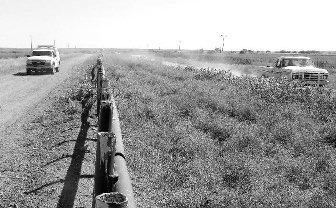 |
 |
 |
 News from Around the Americas | October 2007 News from Around the Americas | October 2007  
US Town Tightens Border Using Low-Tech Ways
 Kevin G. Hall - McClatchy Newspapers Kevin G. Hall - McClatchy Newspapers
go to original


| | A concrete-filled vehicle barrier separates a Border Patrol truck patrolling the U.S. side of the border, left, and a pickup truck driving in Mexico. (McClatchy-Tribune/Kevin G. Hall) |
Most of town's residents say they support solution

Columbus, N.M. - Taking the low-tech approach, the Border Patrol erected three miles of fencing this year around Columbus, where a 1916 raid by Pancho Villa killed 17 Americans and drew an American military force led by Gen. John J. "Black Jack" Pershing. The 15-foot-high metal fence extends west of town about 2.7 miles and east of town three-tenths of a mile.

To the west of Columbus, a waist-high, concrete-filled metal vehicle barrier extends well beyond the fencing. Border Patrol officials wouldn't disclose how much of the vehicle barrier the National Guard has constructed.

But along James Johnson's ranch, which runs right to the Mexican border, the barriers have cut down on pickups freely crossing the common frontier with loads of drugs and illegal immigrants.

"We don't get the very dangerous drive-through traffic that we used to. ... I like the fence," said Johnson, 32, whose family owns 157 square miles of farm and ranch land. "I think the fence is a very good idea. It will not work in all areas, but there are very strategic areas where it will do a good job."

Border Patrol apprehensions for drugs and illegal immigration on this part of the border are down sharply for 2007.

The success of such low-tech efforts stands out against the difficulties the Department of Homeland Security is having rolling out its high-tech "virtual fence." The department has given Boeing Integrated Defense Systems until the end of the year to fix the software problems that have prevented sensors, radars, cameras and mobile units from working together effectively.

Few politicians envision fencing the entire 2,000-mile U.S.-Mexico border. Plans call for 700 miles of fencing, and only 370 miles of that by the end of next year. But the low-tech hardware near the main official border crossings in New Mexico seems to discourage crossings along the state's 180-mile border with Mexico.

"It's like the toothpaste effect. They were squeezing them in Arizona, and now we're pushing them," said Sharon Mitamura, a Luna County sheriff's deputy and border veteran who's seen the flow of immigrants drop as they're forced to cross away from inhabited areas. "A lot of it is desolate desert, and we've had some fatalities; but as far as I can tell, it's made an impression. It's slowed it."

Statistics suggest as much. Border Patrol apprehensions in New Mexico in the last fiscal year, which ended Sept. 30, are down about 44 percent from fiscal 2006, when there were 73,518 apprehensions of illegal immigrants. Cocaine seizures by the Border Patrol have dropped from 1,175 pounds in 2006 to 408 pounds through Aug. 31.

All across the southern border, apprehensions of illegal immigrants are at their lowest level since 1999. In the first 11 months of fiscal 2007, through August, the Border Patrol made 809,056 apprehensions, about 80 percent of the number in the first 11 months of fiscal 2006.

It's not clear, however, whether the declines are because of better enforcement or because more immigrants are eluding authorities.

The high-tech tools against illegal immigration are being tested on a 28-mile stretch of the border near Tucson, Ariz., and around El Paso, and the $20 million project has fallen four months behind schedule because its remotely operated cameras, sensors and computers have had difficulty coping with moisture, distinguishing people from animals or wind, and assembling information in a single picture. Boeing says it has solved most of the problems.

"I think there's disappointment about how it was overly optimistic on how long it would take upfront," said Brad Benson, a Washington spokesman for the Border Patrol's high-tech Secure Border Initiative. "It's not that there's no function. ... Once it's seen as effective" it will be used. | 
 | |
 |



